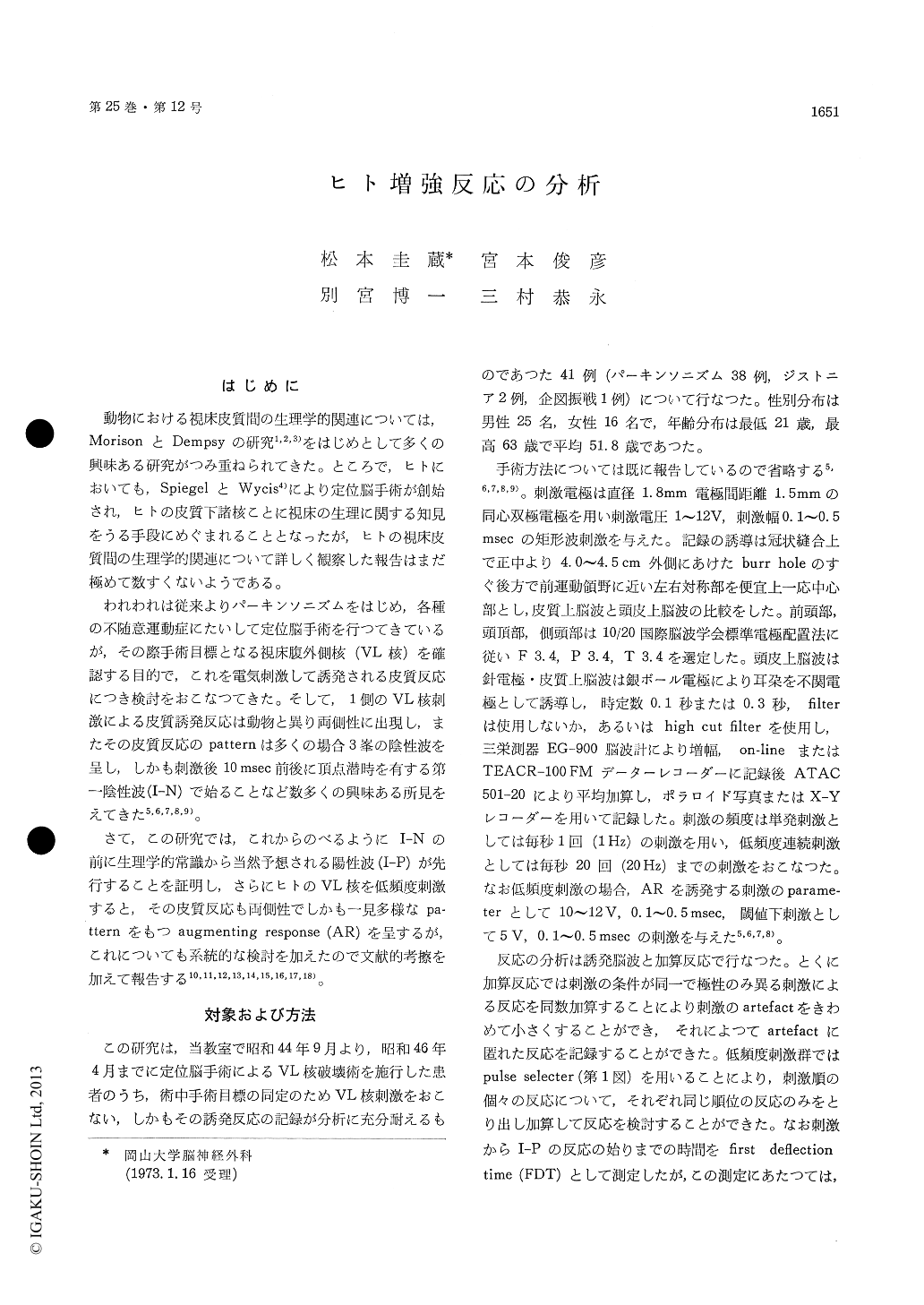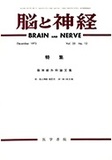Japanese
English
- 有料閲覧
- Abstract 文献概要
- 1ページ目 Look Inside
はじめに
動物における視床皮質間の生理学的関連については,MorisonとDempsyの研究1,2,3)をはじめとして多くの興味ある研究がつみ重ねられてきた。ところで,ヒトにおいても,SpiegelとWycis4)により定位脳手術が創始され,ヒトの皮質下諸核ことに視床の生理に関する知見をうる手段にめぐまれることとなったが,ヒトの視床皮質間の生理学的関連について詳しく観察した報告はまだ極めて数すくないようである。
われわれは従来よりパーキンソニズムをはじめ,各種の不随意運動症にたいして定位脳手術を行つてきているが,その際手術目標となる視床腹外側核(VL核)を確認する目的で,これを電気刺激して誘発される皮質反応につき検討をおこなつてきた。そして,1側のVL核刺激による皮質誘発反応は動物と異り両側性に出現し,またその皮質反応のpatternは多くの場合3峯の陰性波を呈し,しかも刺激後10msec前後に頂点潜時を有する第一陰性波(I-N)で始ることなど数多くの興味ある所見をえてきた5,6,7,8,9)。
Electrophysiolgical studies on evoked cortical potentials following ventrolateral (VL) thalamic stimulation of man were performed with averaging computer technique for 41 patients of parkinsonism and other involuntary movement disorders duringstereotaxic surgery for last 2 years.
1. Single stimulation of the VL nucleus demon-strated bilateral cortical activity with I-PN (first positive negative), II-PN (second positive negative) and III-PN (third positiv negative). III-P wave was frequently superimposed on negative response between II-N and III-N wave, and IV-PN waves were sometimes feeble in single stimulation of the VL nucleus.
2. Peak latencies of these waves were estimated 3.4+1.2 msec in I-P, 10.6+1.8 msec in I-N, 29±5 msec in II-P, 55+6 msec in II-N, 71+11 msec in III P, 90+11 msec in III-N wave in ipsilateral central tead, and 4.0+1.5 msec in I-P, 11.1+2.1 msec in I-N, 31±4 msec in II-P, 57±6 msec in II-N, 74±13 msec in III-P, 92±12 msec in III-N wave in contralateral central lead.
3. The first deflection time of I-P wave, which meant biginning of the evoked response, was 1.5-1.8 msec in stimulated side of central cortex and 2.2-2.9 msec in contralateral central lead, which were obtained 5 cases precisely measured.
4. The impulse, which provoked I-PN waves, was thought to be conducted from stimulated VL nucleus to the contralateral cortex directly via corpus callosum with 36-43 m/sec of velocity.
5. Cortical evoked responses following suprathre-shold low frequency stimulation (5-12 Hz) of the VL nucleus showed invariably augmenting response and recruiting-like augmenting response.
Augmenting response, which consisted of a train of growth in both positive and negative components, was evoked when each stimulus was given on the descending phase from the peak of III-N or aug-mented negativity to the bottom of following posi-tive wave of the preceding response. Analysis of augmentation suggested that synchronization ofpreceding evoked positive wave after III-N and present II-P wave would be occured in augmented positivity and synchronization of preceding evoked N wave after III-N and present II-N or III-N wave would be occured in augmented negativity.
Recruiting-like augmenting respones was obtained when each stimulus was given on the ascending phase from the bottom of deep IV-P to the follow-ing nagative wave of the preceding response. Recruiting-like augmentation was shown to be a similar response as augmenting response in the fundamental pattern of averaged evoked activity, although development of negativity and attenua-tion of positivity caused recruiting-like pattern. Component analysis of recruiting-like augmenting response revealed that predominant development of nagativity was thought to be the result of the synchronization of preceding evoked negative wave after III-N and present II-N or III-N wave. And attenuation of II-P was thought to be the result of the desynchronization of preceding negative wave after III-N and present II-P wave.
Responses following lower frequency stimulation with 4 Hz or less were similar to responses follow-ing single stimulation.
Subthreshold stimulation were thought to be difficult to induce any growth of negative cortical response.
6. It was clarified that cortical evoked response following stimulation of the VL nucleus was in-fluenced by components and phases of the preced-ing cortical response. The facts suggested that human specific thalamic system would play a possible important role in modulation upon cortical electrical activity.

Copyright © 1973, Igaku-Shoin Ltd. All rights reserved.


